ARE GRADUATES FACING UNEMPLOYMENT?
Syllabus
- GS3: Indian Economy and issues relating to Planning, Mobilization of Resources, Growth, Development and Employment.
Why in the News?
- In India, the paradox of rising unemployment rates among highly educated individuals persists.
- Despite an overall decline in the national unemployment rate, graduates face disproportionately high unemployment, revealing a structural challenge in the labor market.
Source: Mint
Youth Unemployment Debate: Then and Now
Historical Echoes (1932)
- In 1932, M Visvesvaraya highlighted the plight of educated individuals facing unemployment, a concern echoing in contemporary discussions on youth unemployment.
Current Discourse (2022)
- Recent events, like the Parliament breach, have reignited discussions on youth unemployment.
- Despite Rahul Gandhi’s critique, official data from the Periodic Labour Force Survey (PLFS) indicates a contrasting trend.
- The unemployment rate, reaching 1% in 2017-18, has notably decreased to 3.2% in 2022-23.
Unveiling Disparities in Youth Employment
Low Overall Unemployment Rates
- Despite a general decline in unemployment rates since 2017-18, a closer examination reveals stark disparities, especially affecting highly educated youth.
Structural Challenge in the Economy
- This challenge isn’t a recent development but appears entrenched in India’s economic structure.
- The crux lies in the economy’s struggle to generate ample employment opportunities for young graduates, intensifying in recent years.
Analyzing the Journey
- Delving into employment data spanning the NSSO surveys of 1993-94 to the PLFS surveys of 2022-23, this analysis employs the UPSS classification.
- Focused on individuals aged 18 to 65, it sheds light on the intricate patterns of employment and unemployment over nearly three decades.
Education’s Impact on Jobs
Historical Trends
Source: The Hindu
- Examining unemployment rates for the overall workforce aged 18 to 65 (Figure 1), historically, rates were consistently low since the early 1990s.
- However, a significant spike occurred in 2017-18, reaching a peak of 5.77%.
Recent Changes
- As of 2022-23, there’s a positive shift with the unemployment rate dropping to 3.15%, signaling an improvement.
- Although rates remain higher than previous decades/
- This marks a notable reduction from the 2017-18 peak, suggesting evolving dynamics in the job market.
Higher Education’s Paradox
Graduate Dilemma
Source: The Hindu
- The relationship between higher education and job prospects in India has been intricate since the 1990s.
- Examining Figure 2, it’s evident that individuals with graduate degrees encounter higher unemployment rates compared to the general population.
Fluctuating Rates
- Tracking the trajectory, these rates evolved.
- In the 1990s, they stood around 9%, improving to 7.66% by 2011-12.
- However, a concerning spike ensued, reaching 17% in 2017-18.
- The latest data in 2022-23 shows a reduction to 13%, indicating a fluctuating landscape for job opportunities among graduates.
Figure 3 Unveiling Realities
Source: The Hindu
- Focused on young workers aged 18 to 29 with graduate degrees, Figure 3 exposes the tumultuous journey.
- In 1993-94 to 2004-05, a significant 20-25% faced prolonged unemployment spells of 6 months or more.
Shifting Fortunes
- The scenario improved in 2011-12, dropping to 20%, only to shockingly surge to 36% in 2017-18.
- Encouragingly, by 2022-23, there’s relief as the rate reduces to 27%, portraying the evolving challenges faced by young graduates in securing stable employment.
Educational Shifts: Impact on Unemployment
Gradual Transformation
Source: The Hindu
- In 1993-94, merely 5% of the labor force held graduate degrees, a modest representation depicted in Figure 4.
Rising Graduates (2022-23)
- Over time, the educational landscape transformed, witnessing a surge in higher education.
- By 2022-23, graduates constitute approximately 15% of the labor force, signaling a substantial increase.
Low Unemployment, High Concerns
- Despite seemingly low overall unemployment rates, the plight of graduates persists due to their expanding share in the labor force.
- As enrollment surges, the share of graduates will likely rise, posing challenges for young job-seekers and spotlighting a concerning facet of the Indian labor market.
Crucial Challenge: Youth Unemployment
Serious Concerns
- The challenge of youth unemployment demands urgent attention, recognizing it as a pressing issue with far-reaching consequences.
Factors under Scrutiny
- Unraveling the complexities, a comprehensive effort is needed to identify the precise factors behind unemployment among the highly educated.
- This involves scrutinizing the effectiveness of the education system in imparting essential skills and assessing the economy’s capacity to generate sufficient jobs for the growing influx of educated job-seekers.
Preserving Aspirations
- The imperative is clear — meticulous exploration and targeted interventions are vital to safeguard youth aspirations, ensuring the effective utilization of the demographic dividend.
| Structural unemployment
· Structural unemployment refers to a persistent mismatch between the skills possessed by the workforce and the requirements of available jobs, creating a prolonged disconnect in the labor market. Reasons of Structural unemployment Technological Advancements · Automation and digitization in sectors like manufacturing and data entry are displacing human labor. · Example: The automation-driven decline of jute mills in West Bengal resulted in substantial job losses for both skilled and unskilled workers. Globalization · Outsourcing jobs to countries with lower labor costs, impacting industries like textiles and garments in India. · Example: The influx of cheap imports, particularly from China, led to the closure of numerous garment factories in India, causing widespread unemployment. Changes in Consumer Preferences · Shifts in consumer demand can render certain skills or products obsolete, impacting related industries. · Example: The decreasing preference for coal-based power generation is affecting jobs in the coal mining sector. Deindustrialization · The transition from manufacturing to service-based economies can result in job losses in traditional industries. · Example: The decline of the steel industry in places like Bhilai and Durgapur has led to significant unemployment. Skill Mismatch · The education system may not align with the evolving job market, leading to a gap in required skills. · Example: High unemployment among engineering graduates highlights a disparity between academic qualifications and industry needs. Geographical Factors · Job concentration in specific regions may create challenges for skilled workers located elsewhere. · Example: The concentration of IT jobs in major cities like Bangalore and Hyderabad poses challenges for skilled workers in other parts of the country. |
Source
https://www.thehindu.com/business/Economy/are-graduates-facing-unemployment/article67676487.ece
Mains Practice Question
Examine the historical patterns and socio-economic changes contributing to the consistently higher unemployment rates among highly educated individuals in India since the 1990s. Highlight the structural features of the Indian economy that contribute to challenges in generating employment for young graduates.

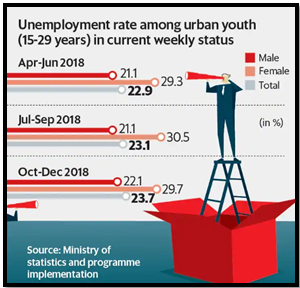 Source: Mint
Source: Mint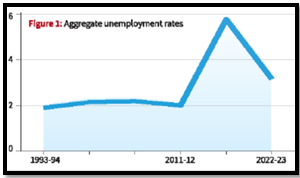 Source: The Hindu
Source: The Hindu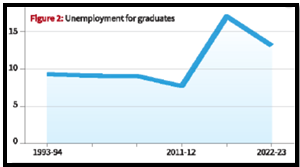 Source: The Hindu
Source: The Hindu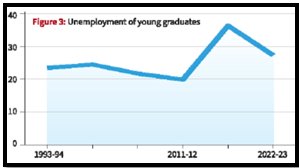 Source: The Hindu
Source: The Hindu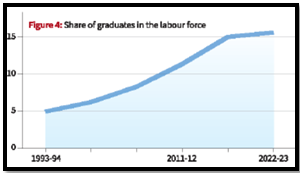 Source: The Hindu
Source: The Hindu

